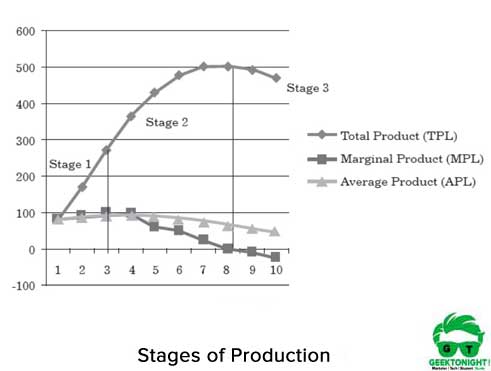Table of Content
Law of Diminishing Returns Definition
As equal increments of one input are added; the inputs of other productive services being held, constant, beyond a certain point the resulting increments of the product will decrease, i.e., the marginal product will diminish.
G. Stigler
As the proportion of one factor in a combination of factors is increased, after a point, first the marginal and then the average product of that factor will diminish.
F. Benham
An increase in the Capital and Labour applied in the cultivation of land causes, in general, less than proportionate increase in the amount of produce raised unless it happens to coincide with an improvement in the art of agriculture.
Alfred Marshall
If the input of one resource to other resources is held constant, total product (output) will increase but beyond some point, the resulting output increases will become smaller and smaller
Richard A. Bilas
The law of diminishing returns is an important concept of economic theory. This law examines the production function with one variable keeping the other factors constant.
It explains that when more and more units of a variable input are employed at a given quantity of fixed inputs, the total output may initially increase at an increasing rate and then at a constant rate, and then it will eventually increase at diminishing rates.
It implies that the total output initially increases with an increase in variable input at a given quantity of fixed inputs, but it starts decreasing after a point of time.
Assumptions of Law of Diminishing Returns
The main assumptions made under the law of diminishing returns are
as follows:
- The state of technology is given and changed.
- The prices of the inputs are given.
- Labour is the variable input and capital is the constant input.
Law of Diminishing Returns Example
Let us understand the law of diminishing returns with the help of an example. Suppose an organisation has fixed amount of land (fixed factor) and workers (variable factor) as the labour in the short-run production. For increasing the level of production, it can hire more workers. In such a case, the production function of the organisation would be as follows:
Q= f (L), K
Q = Total Production
L = Labour
K = Capital (Constant)
Table shows the law of diminishing returns:
| No. of Workers (L) | Total Product (TPL) | Marginal Product (MPL) | Average Product (APL) | Stages of Production (on the basis of MPL) |
|---|---|---|---|---|
| 1 | 80 | 80 | 80 | Increasing return |
| 2 | 170 | 90 | 85 | Increasing return |
| 3 | 270 | 100 | 90 | Increasing return |
| 4 | 368 | 98 | 92 | Diminishing return |
| 5 | 430 | 62 | 86 | Diminishing return |
| 6 | 480 | 50 | 80 | Diminishing return |
| 7 | 504 | 24 | 72 | Diminishing return |
| 8 | 504 | 0 | 63 | Diminishing return |
| 9 | 495 | -9 | 55 | Negative return |
| 10 | 470 | -25 | 47 | Negative return |
From Table 1, we can see that MP of labour rises till 3 units of labour. Beyond this point, the MP of labour starts decreasing. After using the 8 units of labour, the MP of labour starts becoming negative.
In Table 1, the last column shows the three stages of production, which are explained as follows:
Stage I: Increasing returns: It refers to the stage of production in which the total output increases initially with the increase in the number of labour. Table 1 shows the increase in the marginal product till the number of workers increased to 3.
Stage II: Diminishing returns: It refers to the stage of production in which the total output increases, but marginal product starts declining with the increase in the number of workers. Table 1 shows the declining of marginal product as the number of workers reaches 4.
Stage III: Negative returns: It refers to the stage of production in which the total product starts declining with an increase in the number of workers. As shown in Table 1, the total output reaches to maximum level at the 8th worker. After that, the total output starts declining. A marginal product becomes negative at this stage.
Figure 1 shows the graphical representation of the three stages of production:

From Figure 2, the following can be inferred:
- Stage 1: MPL> APL
- Stage 2: MPL< APL (both greater than zero)
- Stage 3: MPL<0, APL > 0
Importance of Law of Diminishing Returns
The law of diminishing returns has a very wide application. Earlier, it was thought that the law of diminishing returns can be applied only to the agriculture field. However, now it is held that the law of diminishing returns can be applied in all the fields, namely, agriculture, mining manufacturing, etc.
The validity of the law of diminishing returns is based upon the empirical evidence. This can be explained by an instance.
Suppose if there are no diminishing returns to scale, the production in an economy can be increased by increasing the number of labour and capital. The whole population can be fed by growing crops on tiny pieces of land. As the demand increases with the increase in population, more labour and capital can be used to increase the output. Thus, there would be no starvation and recession.
However, this is not true in the real world. Also, it is not possible to keep pace with technology and capital with the increasing population. The law of diminishing returns determines the optimum labour required to produce the maximum output.
In Figure 1, stages 1 and 3 depict the increasing and negative returns, respectively. If an organisation is in stage 1 of the production, more increase in labour is required to increase the production. If an organisation is in stage 3, then it needs to reduce the labour to reduce production.
Thus, only stage 2 is important that depicts the diminishing returns. This stage provides information about the number of workers that needs to be employed for reaching the maximum level of production. Thus, this stage is helpful in making important business decisions.
Also Read: Cardinal and Ordinal Utility
Business Economics Tutorial
(Click on Topic to Read)
Go On, Share article with Friends
Did we miss something in Business Economics Tutorial? Come on! Tell us what you think about our article on Law of Diminishing Returns | Business Economics in the comments section.
Business Economics Tutorial
(Click on Topic to Read)













